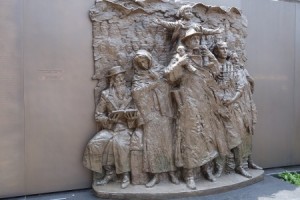
Throughout history, Jews have migrated to diverse corners of the world. Thus, I usually search for traces of Jewish life whenever I travel. With just a few days in Shanghai, I eagerly did a Google search. In a matter of seconds, I saw found Jewish Shanghai tours. I simultaneously gathered a few bits and pieces about Jewish history in Shanghai.
Many of the facts that I viewed online were reiterated by our guide, Dvir Bar-Gal. I never would have dreamed that a middle-aged Israeli documentarist, video grapher, and photojournalist would be leading Jewish tours in Shanghai.
The group tour began in The Bund area. It didn’t take long before the group learned the role that Jews played in the development of this notable part of Shanghai. Sephardic Jewish businessmen started traveling to Shanghai after the execution of the 1842 treaty. The terms of this document permitted Shanghai and four other cities along China’s eastern coast to be open to foreign traders. Within a few years, new business opportunities encouraged Jewish entrepreneurs to check out Shanghai. This first group was comprised of Jews from Baghdad, Bombay, and Cairo.
As Dvir quickly mentioned some of the noteworthy members of the Sassoon, Kadoorie, Hardoon, Ezra, Shamoon, and Boroukh families, he shared black and white portrait pictures. These successful international businessmen traded in cotton and became involved in the opium trade, real estate, banking, shipping, and utility industries. Using their ties to their respective affluent families and the international community, they maximized their holdings. Some were key players in the building of Shanghai’s landmark buildings including Sassoon House, the Metropole Hotel, Grosvenor House, the Embankment Building, Hamilton House, and Cathay Mansions. Dvir continued to share pictures and pointed out the location of some of these famous places and the impact that these successful Jews had on Shanghai. It was a challenge to keep everything in perspective as he rattled off an abundance of facts.
Opium and Jews are two words that usually do not go together. But in the 19th century, opium was a lucrative Shanghai commodity that was controlled by David Sassoon. From the 18th century, the Sassoons were frequently acknowledged as one of the wealthiest families in the world. Many refer to this family as the “Rothschild’s of the East”. David’s grandson, Sir Victor Sassoon, is considered one of the city’s leading property developers in the 1930s. He was responsible for the construction of buildings such as Broadway Mansions, Embankment House, and the Cathay Hotel – one of Asia’s finest hotels. Sassoon worked with architects and developers to change the Shanghai skyline and to create the first skyscrapers in the Eastern Hemisphere. He is considered among the world’s half-dozen richest men of his time.
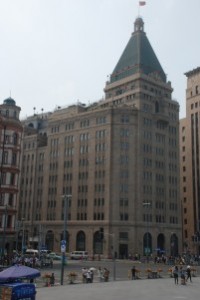
The current Peace Hotel opened in 1929 as the Cathay Hotel. Many cited it as the most luxuroious hotel east of the Suez Canal. In 1992, it was listed as one of the famous hotels of the world by the World Hotel Association.
In 1880, Elly Kadoorie began his career with David Sassoon. After gaining experience, he launched his own businesses and made a fortune from banking, real estate, and rubber production. During World War II, Elly was interned by the Japanese and died in prison. In the late 1930, his son, Horace Kadoorie, formed the Shanghai Jewish Youth Association (S.J.Y.A) otherwise known as the Kadoorie School. Eventually, it became the largest Jewish School in Shanghai and provided a supportive network for refugee families. This school closed in 1949.
Descendants of the Kadoorie family now live in Hong Kong where they are well-known for their contribution to business and charity work. Elly’s grandson Michael, proudly remembers his heritage. A sign outside his office spells out his lineage- “Sir Elly Kadoorie and Sons Ltd.” Michael is the chairman of CLP Holdings Ltd. This entity operates a utility company that provides electricity to 75% of the entire province of Hong Kong and has interests in Chinese, Australian and Indian power plants. This entity also owns the world-renowned Peninsula Hotel Group.
Prior to World War I, the Jewish population in Shanghai was approximately 700 and was mostly Sephardim from Baghdad origin. Russian Jews fleeing the 1917 Revolution were the next wave of immigration. These Jews were less affluent and were looking for better work opportunities. They added another dimension to the Shanghai Jewish community and raised awareness of the Zionist movement.
By the 1920s, the Shanghai Jewish community had grown to almost 2000 people and was showing significant signs of success. Many continued to be prime movers in the development of Shanghai. The community had several synagogues, a school, two cemeteries, a hospital, and Jewish shops.

Today, only two of these synagogues remain. One is the Ohel Rachel Synagogue that opened in 1921.
Ohel Rachel was modeled after the Portuguese Bevis Marks Synagogue in London. It was dedicated to Sir Jacob Elias Sassoon and his wife Lady Rachel. The sanctuary holds approximately 700 people and at one point housed 30 Torah scroll in its walk-in ark. The adjoining property had a Jewish school, a playground, library, and mikveh. Now the Chinese government owns this Jewish landmark and restricts access.
The second synagogue, Ohel Moishe Synagogue, was established by the Ashkenazic Russian Jews in 1907. It moved to its present location in 1927. Today, the building is part of the Shanghai Jewish Refugee Museum.
After visiting The Bund area, the tour group was transported to the vicinity of Huoshan and Zhoushan Roads. This is where the Japanese occupation authorities created a “Designated Area for Stateless Refugees.” The boundaries for this area were Gonping Road, Tongbei Road, Haimin Road, and Zhoujiazui Road in the Hongkew district. Until the end of the war, Shanghai Jews were corralled into a semi-interment camp.
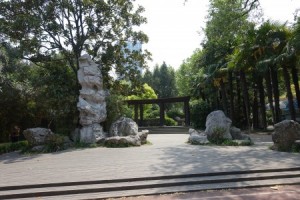
Our first stop was Huoshan Park.
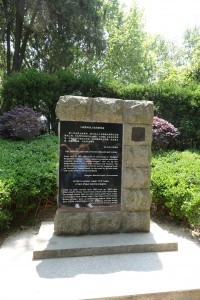
We stood before a small monument that memorializes the Jewish refugees who lived here during World War II. We sat in a sheltered area and listened to Dvir talk about this remarkable group of Jews (approximately 20,000) who found their way to Shanghai. About two-thirds of the refugees came from Austria and Germany while the others were mostly from Eastern European countries. Shanghai and the Dominican Republic were the only places in the whole world that welcomed Jewish refugees.
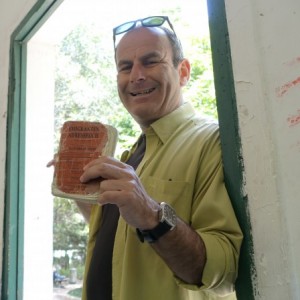
He passed around a tattered red book that documented the names of the people who made the journey. It was chilling to see several people with the last name- Bornstein.
After leaving the park, Dvir pointed out several notable buildings. The Shanghai government has made efforts to preserve some of the European classical style buildings that were built in the late 1920s. Jewish refugees including Michael Blumenthal (Secretary of Treasury in Carter Administration) and Shaul Eisenberg (founder of Eisenberg Group in Israel) lived in this area during World War II.
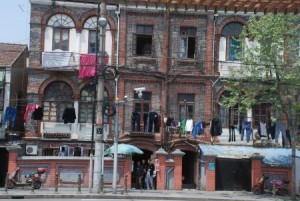
The American Jewish Joint Distribution Committee (JDC) was housed in the above building which was built in 1910. In 1941, the JDC dispatched two representatives, Laura Margolis and Manny Siegel to help settle the refugees. They organized kitchens that feed approximately 10,000 people per day. Without these kitchens, the mortality rate would have been high. After Pearl Harbor, the JDC representatives were forced to communicate via third countries. Both Margolis and Siegel were classified as enemy aliens. In 1943, when they were interned. After the war, the JDC assisted approximately 16,000 Jews to emigrate from China.
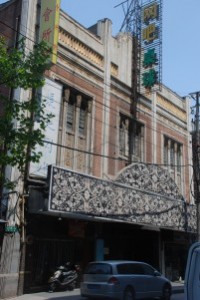
We stood across the street from the Mascot Roof Garden. It was a popular spot for Jewish artists and musicians.
The established Shanghai Jewish community did not hesitate to meet the needs of the Jewish refugees who left Nazi Germany. Sir Victor Sassoon, Paul Komor (1886-1973), a Hungarian businessman, along with several others founded the International Committee for European Immigrants in China. This institution helped the influx of refugees and issued identification cards to the Jewish refugees whose passports had been confiscated or invalidated. This simple document gave the refugees “legal” status in Shanghai. A plaque inside the museum recalls Paul’s humanitarian actions.
Included among the refugees were rabbis, administrators, and students from the Mir Yeshiva, the second most important yeshiva in Lithuania. This yeshiva was the only one in Europe to survive the Holocaust. The Righteous Gentile, Sugihara Chiune, (the Japanese Consul in Kovno) helped some of these pious people as well as many others find their way to Shanghai.
A less known Righteous Gentile, Feng-Shan Ho, courageously issued Chinese visas to Jews fleeing prewar Vienna. As the Chinese Consul-General in Vienna, he chose to disregard his superior’s orders. Despite the strong possibility of disciplinary actions, he helped Jews who needed a visa to leave Nazi controlled areas. The Chinese government punished Dr. Ho with a demerit for his disobedience. After World War II, Chinese nationalists in Taiwan discredited Dr. Ho. He was impeached and then denied a pension for his 40 years of diplomatic service. An internet search has not revealed any evidence that his name was ever cleared by Taiwan authorities.
In 2000, Yad Vashem posthumously awarded Feng-Shan Ho the title of Righteous Among the Nations for his humanitarian courage in issuing Chinese visas to Vienna Jews despite stern orders from his superiors.
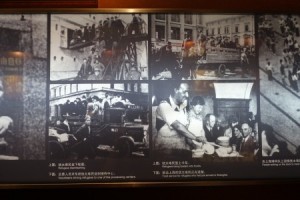
During the war years, Ohel Moishe Synagogue (the Ashkenazi synagogue) was a meeting place for the Jewish community in the Hong Kou district. Surrounding buildings provided communal services for the influx of Jews who were seeking a safe haven.
After the Japanese invaded China in 1937, they occupied Shanghai. After Pearl Harbor, the Japanese occupiers closed Shanghai to new immigration. However, they deported most of the Jewish refugees living in Japan and those trapped in the Far East to Shanghai.The Nazis tried to persuade the Japanese to build death camps on Chongming Island. Fortunately, the Japanese were not interested. From 1941 to 1945, the Japanese government considered the Shanghai Jews who were citizens of Allied countries to be “stateless refugees.” They closed Jewish immigration in 1941. The Jews were corralled into unsanitary semi-interment camps in the Hongkew district and remained under the control of the Japanese occupiers until they were liberated on September 3, 1945
At the conclusion of the war, there were about 25,000 Jews. When the People’s Republic of China was founded in 1949, almost all of the Jews had moved to Israel, the US, Australia, or Hong Kong.
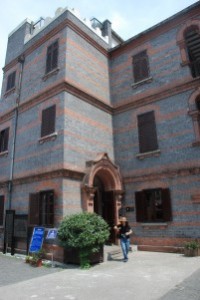
In 1994, Israeli Prime Minisiter Yitzhak Rabin (1922-1995) visited the Ohel Moishe Synagogue and publicly thanked the people of Shanghai for their humanitarian behavior during World War II. Ten years later, it was listed among Shanghai’s historic treasures.
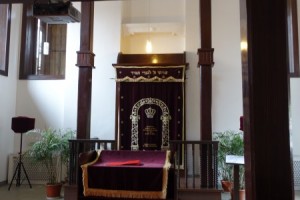
Inscribed on the velvet Ark covering are the words- “Tribute to Hongkou people who provided refuge to Jews in time of need. Consulate General of Israel in Shanghai.”
In 2007, the Government of Hongkou District used special funds to return the synagogue back to its original condition. A visit to this synagogue will include a tour of the Shanghai Jewish Refugee Museum that focuses on life during the prewar and war years.
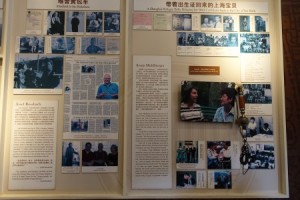
The museum showcases Shanghai’s Jewish history using photos, artifacts, art, and a video. Biographical sketches of a couple dozen Jews provide a personal touch.
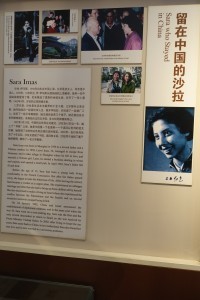
Biographical sketches of a couple dozen Jews provide a personal touch.
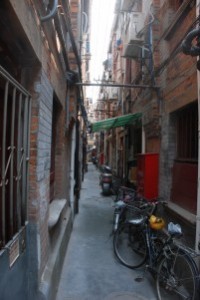
Next, Dvir had us walk around the neighborhood. Along the way, we passed by many narrow streets. Our tour concluded in a small apartment.
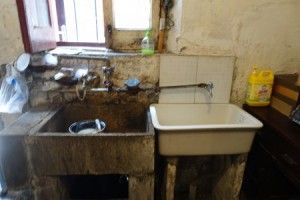
The structure was primitive and the occupants had minimal possessions. It was hard to fathom how this tiny place could be shared with several other families. Each family had a designated sink and small living area. A narrow wooden stairway led to upstairs living quarters.
A walk through this neighborhood stood in sharp contrast to the notable architecture in The Bund area.
Dvir told us about the Shanghai Memorial Project. For more than a decade he has diligently searched for gravestones that once proudly marked Shanghai Jewish graves. In the 1950s, the Shanghai government relocated all of the foreign graves to one location. This foreigners’ cemetery was eventually destroyed. Some of the sturdier tombstones were taken by local villagers to use as construction materials while others were sold or lost. These precious pieces of Shanghai Jewish history were scattered. Dvir and a small group of supporters are committed to establishing a memorial that honors these remnants of Shanghai Jewish history. For more information visit the Shanghai Memorial Project website.
Reflection
Unfortunately, one needs to look primarily to Jewish sources to read about the role that Jews played in pre Communist Shanghai. Hopefully the government controlled Shanghai Jewish Refugee Museum and Dvir’s dedication to preserving Jewish history will prevent this topic from being lost. Much is to be gained from learning about how the people and government of Shanghai, Righteous Gentiles, prestigious local Jews, and the JDC actions prevented the annihilation of Shanghai Jewry during World War II. However, mass emigration caused the once vibrant Jewish community to vanish as the Communists took control. Over the last few decades, a Jewish presence is returning. Time will tell what impact these individuals will have on Shanghai’s future history.
Related Posts
Taormina- A Lovely Place With a Troubling History
Looking For Greek Jewish History
A Step Back in Time- The Jewish Catacombs in Rome
Hamat Teverya National Park- An Historical Gem in the Galilee
Sandra’s Bio
Sandra Bornstein is the author of MAY THIS BE THE BEST YEAR OF YOUR LIFE. It is available on Amazon. Sandra’s memoir highlights her living and teaching adventure in Bangalore, India. She is a licensed Colorado teacher who has taught K-12 students in the United States and abroad as well as college level courses. Sandra is married and has four adult sons. The memoir was a finalist in the Travel category for the 2013 Next Generation Indie Book Awards, the 2013 International Book Awards, the 2013 National Indie Book Excellence Awards, the 2013 USA Best Book Awards, and received an Honorable Mention award in the Multicultural Non-Fiction category for the 2013 Global ebook Awards.
Leave a Reply
You must be logged in to post a comment.